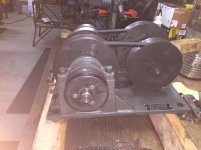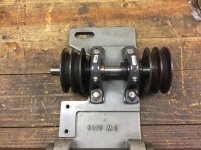projectnut
Stainless
- Joined
- Mar 4, 2006
- Location
- Wisconsin
Rebuilding a Worthington Model 3B AllSpeed Drive
I am in the process of rebuilding the Worthington drive in a Sheldon lathe. I have removed the drive and disassembled it. One puzzling note is the way the bearings fit in the central housing. The OD of the bearings is 2.8346" while the bore in the housing is 2.8350. Essentially it's a slip fit. I have found replacement bearings and they have the exact same OD as those currently in the machine. There are no signs of wear either on the housing or the bearings.
The only information I can find for the bearing fit is one sentence in a parts manual that reads they are a "C3 loose fit". I'm not sure what the specification is for a C3 loose fit. While the inner race of the bearing is press fit on a shaft it seems the outer race should not be able to rotate in the housing.
Any insight would be appreciated
I am in the process of rebuilding the Worthington drive in a Sheldon lathe. I have removed the drive and disassembled it. One puzzling note is the way the bearings fit in the central housing. The OD of the bearings is 2.8346" while the bore in the housing is 2.8350. Essentially it's a slip fit. I have found replacement bearings and they have the exact same OD as those currently in the machine. There are no signs of wear either on the housing or the bearings.
The only information I can find for the bearing fit is one sentence in a parts manual that reads they are a "C3 loose fit". I'm not sure what the specification is for a C3 loose fit. While the inner race of the bearing is press fit on a shaft it seems the outer race should not be able to rotate in the housing.
Any insight would be appreciated
Last edited:









